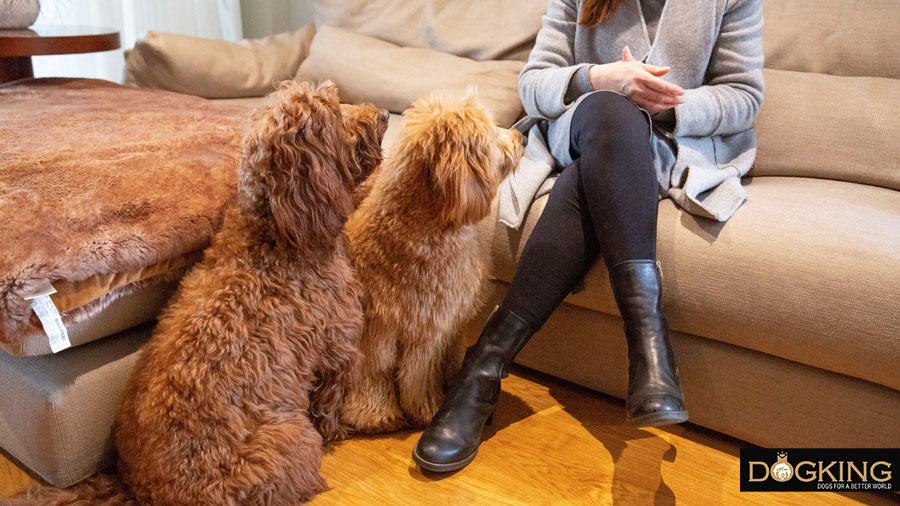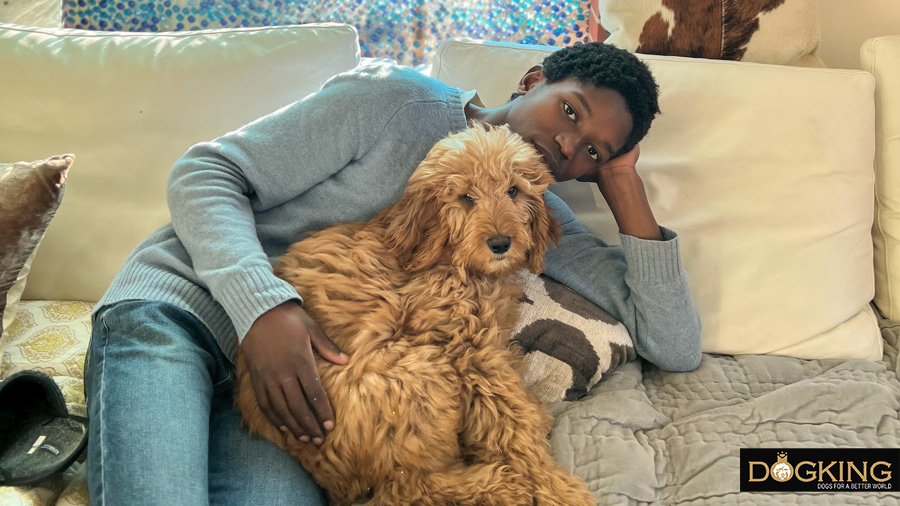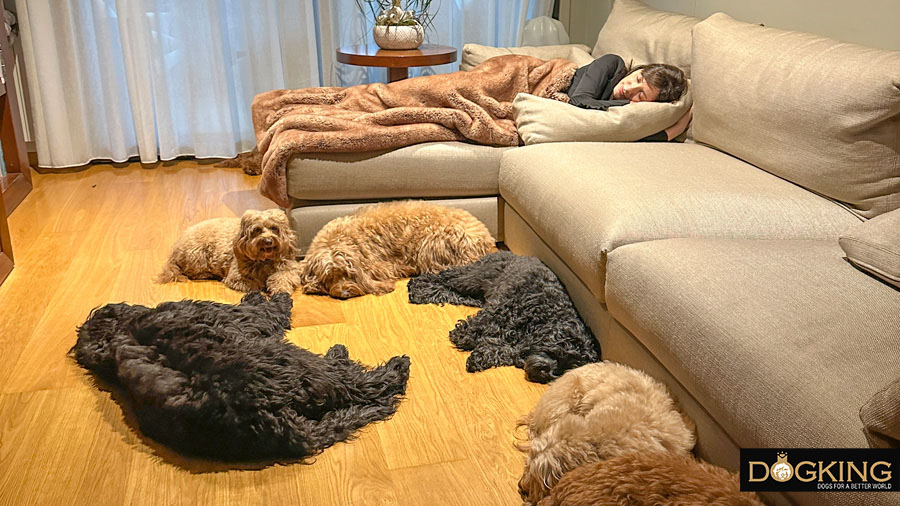Dovresti lasciare salire il tuo cane sul divano?
Sapere quando e come impostare limiti

BUONA EDUCAZIONE IN CASA
Tempo di lettura approssimativo : 7 minuti
Godere di un momento di riposo con il tuo cane è uno dei più grandi piaceri che esistono. Ma il divano è un buon posto? Tenendo conto del fatto che dobbiamo evitare di umanizzare il nostro cane e che non tutte le razze hanno esattamente gli stessi istinti o temperamenti, la risposta a questa domanda dipenderà dai comportamenti che possono sorgere o sono già scaturiti nel tuo cane.
In questo articolo spieghiamo quando non è consigliabile far salire il tuo cane sul divano, cosa dovresti prendere in considerazione se lo lasci e come puoi impedire che lo faccia.

Indice di contenuto
1- È corretto che il tuo cane salga sul divano?
2- Come impedire al tuo cane di salire sul divano
3- Cosa dovresti tenere a mente se condividi il divano con il tuo cane
È corretto che il tuo cane salga sul divano?

Il problema della dominanzaAlcuni proprietari, basati sul pensiero classico, di solito hanno paura che il cane diventi dominante o adotti un comportamento possessivo se sale sul divano o sul letto. Essere dominante è la capacità di controllare una o più risorse da parte di un individuo. Questo fa si che il cane senta la libertà di fare ciò che è più gratificante per se stesso e creda di avere il possesso totale della risorsa. Sebbene il motivo non sia voler assumere il ruolo di leader all'interno del suo branco, come nel nella gerarchia del branco, essere dominante a determinati fattori come il divano, può portare reazioni negative quando viene neganto l'accesso a ciò che è di sua proprietà.
Come impedire al tuo cane di salire sul divano
Se non abbiamo evitato che salga sul divano, dobbiamo astenerci dal rinforzare il comportmento per fare si che quel comportamento si estingua. E va ricordato che non premiare comportamenti è considerato un rinforzo, ma in questo caso non dove essere fatto (negativo).
E se è già salito, come lo faccio scendere dal divano?
- Se vogliamo che il nostro cane scenda dal divano, dobbiamo accompagnarlo e guidarlo delicatamente cercando di toccarlo fisicamente il meno possibile, poiché deve imparare a scendere di propria volontà. Le punizioni e le correzioni non sono le più consigliabili nella fase di edicazione di un cane, poichè solo evidenzia una gerarchia che consente ai nostri amici a quattro zampe di obbedire ai segnali comunicativi.
- Inoltre, le correzioni non dovrebbero mai essere aggressive o implicare l'uso della forza, ma mostrate attraverso un tono di voce fermo e con gesti che il cane associa a comportamenti che non dovrebbe realizzare. Il semplice fatto di rimuoverlo il posto in cui vuole stare come il divano, per esempio, è già un tipo di punizione.
- Una volta sceso dal divano dobbiamo premiare con un rinforzo positivo (carezze, cibo o parole piacevoli) per far capire che scendere dal divano comporta una ricompensa. Nel caso in cui al nostro cane non piaccia stare a terra o non è abituato, troveremo un nuovo posto di riposo come un lettino o un cuscino, che può sostituire il divano. Esporremo l'oggetto e una volta salito, tocato o annusato, premieremo fino a quando il nostro cane non rimane sopra e non scende.
- Una volta rafforzato il comportamente di stare nel nuovo posto di riposo, gli daremo il segnale "al tuo posto". Lo faremo solo se tutte le sue necessità sono state soddisfatte in precedenza (andare a fare una passeggiata, mangiare, ecc.), dal momento che non possiamo aspettarci che il nostro cane si riposi se ha trascorso tutta la sua giornata a casa, per esempio. Dobbiamo essere coerenti, facilitare il lavoro che bilancia i suoi livelli di energia e rendendolo un'esperienza divertente e motivante per entrambi.
Cosa dovresti tenere a mente se condividi il divano con il tuo cane
I limiti nei comportamenti canini
Perché sono necessari?
Il miglior modo che abbiamo per esprimere il nostro amore è garantire la sicurezza sia mentalmente sia fisica del nostro cane e per questo dovrai stabilire determinati limiti. I limiti, se sono interiorizzati fin da cuccioli, sono per tutta la vita e favore di una coesistenza in armonia con il resto della nostra società, come accade nel branco. Dopotutto, consentire comportamenti che non sono corretti, non solo non li farà avere la necessaria comprensione per sentirsi accettati dal resto degli umani e dei cani. Ma oltre a poter ostacolare il suo apprendimento, salire sul divano può anche essere un problema di igiene a seconda della razza per la quantità di peli che il tuo cane perde e soprattutto se in casa c'è qualcuno con allergie.
Quando dovremmo marcare i limiti?
Tutto dipenderà, in gran parte, dal tipo di razza. Alcuni avranno nel loro DNA una maggiore predisposizione allergenica, o avere istinti più dominanti o possessivi che creerà maggior resistenza per scendere dal divano contro la propria volontà. Pertanto, se il tuo cane ha difficoltà a imparare i limiti a causa del suo temperamente e carattere, mostrando aggressività di fronte alla protezione delle risorse o appartiene a una razza che di solito perde molto pelo, sarà meglio assegnare a nuovo posto dove riposare in alternativa al divano.

Nel caso degli Australian Cobberdog, dotati da un carattere di facile recettività per la loro straordinaria intelligenza e un manto ipoallergenico, sono cani d'eccellenza. Insegnare loro a salire o scendere dal divano non comporta alcuna difficoltà, ma al contrario dato il loro infinito desiderio di imparare. E la cosa importante per loro è il fatto di poter stare con te, non importa dove, educarlo è un'attività che piaccerà sia a te che a lui, e che il divano è qualcosa che finisce in secondo piano.